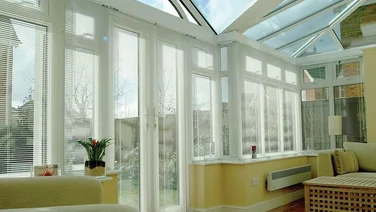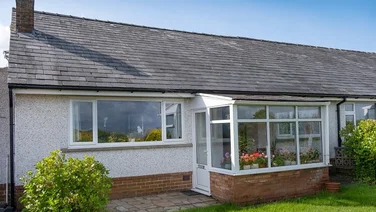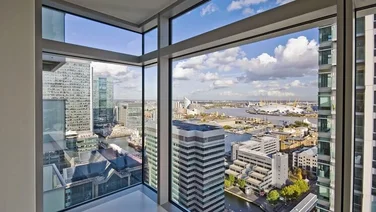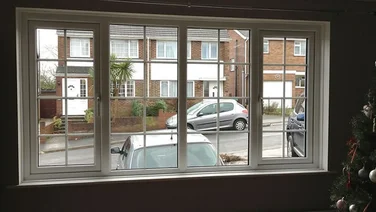- The average double-glazed bay window costs £1,650
- A bay window will typically add thousands of pounds to your home’s value
- The cheapest frame option is uPVC
Double-glazed windows cost a lot, and bay windows are the most expensive kind. However, many homeowners think they are worth the price since a bay window could increase a home’s value while also adding extra natural light, airflow, and views of the outside world.
To help you determine if a bay window is right for you, we’ve covered the costs, potential designs, and frame options before explaining exactly why you should and shouldn’t take the plunge.
If you’re ready to get the double-glazed bay window of your dreams, compare the best prices by clicking a few details in our easy-to-use quote tool.
We’ll pass on your details to our expert suppliers, who’ll get in touch with free quotes.
What type of double glazing do you need?
Get started
What are double-glazed bay windows?
A double-glazed bay window is usually a set of at least three individual windows that project outwards from the main external wall of a building. They usually form interesting architectural details and can be sought after by homeowners.
This centuries-old design adds internal space to your property, improves airflow within your home, and allows more natural light in – plus, it will enable you to see more of the outside world.
All the windows installed will be double-glazed, as they are in 87% of English homes.
How much do double-glazed bay windows cost?
A double-glazed bay window with four panes will cost £1,650 on average.
That’s expensive for a window installation, but you’re not just getting new, double-glazed windows. You’re also getting a section of your home redesigned to be more visually appealing – from the inside and outside.
One way you can cut back on costs is to install the double glazing yourself, but we wouldn’t recommend this – you could end up damaging your property and even injuring yourself.
It’s also worth considering that new double-glazed windows can save you up to £140 per year, according to the Energy Saving Trust. You can find out more about double-glazing costs with our helpful guide.
Here’s how much different sizes of bay windows will cost you, on average, followed by a table showing how the most popular frame materials will affect the price.
| Number of panes | Average cost |
|---|---|
| 3 | £1,250 |
| 4 | £1,650 |
| 5 | £2,150 |
Data from Checkatrade, January 2025.
| Frame material | Cost for 4 panes |
|---|---|
| uPVC (unplasticised polyvinyl chloride) | £1,650 |
| Aluminium | Circa 25% more tha uPVC |
| Timber | Circa 50% more tha uPVC |
Data from Checkatrade and Everest, January 2025.
What type of double glazing do you need?
Get startedThe different types of double-glazed bay windows
Now that you’ve considered the costs, the next step is to work out which design you’d like to use for your bay window.
The most common types are splay, box, and bow. Here’s what you can expect from each one.
Splay
The splay (also known as a canted window) is the classic bay design, with a large, front-facing pane of glass flanked by two or more smaller panes angled diagonally away from the centre, at around 45 degrees.
In most splay bays, the central pane is fixed, but the side panes are sash windows, meaning you can open them from the top or bottom.
Box
The clue is in the name. A box bay features at least one flat middle pane, and two sides that face away from the centre at 90 degrees.
This shape, which is also known as a square bay, stands in contrast to more rounded designs, and is also starker than a splay design.
However, many homeowners enjoy its straight lines and simplicity, along with the opportunities it gives for a window seating area.
Bow
To achieve a bow bay, your installer will typically take four or five identical panes of glass, and fit them at roughly 10 degree increments, leaving you with a smooth semi-circle.
You can also request a circle window, which is a more rounded version of a bow window. This effect is usually achieved by adding in more panes, so that the curve is more gradual, and therefore smoother.
A bow window will usually be more expensive than the designs above, because they involve more panes of glass.

What’s the best material for a bay window frame?
You’ve looked at costs and designs – now it’s time to consider the best options for framing your bay window. The most common frame choices are uPVC, aluminium, and timber – plastic, metal, or wood, to put it simply.
They all have different strengths and weaknesses in terms of their aesthetics, durability, lifespan, and environmental impact.
uPVC bay windows
If you decide to buy uPVC windows, you’ll be picking the cheapest option – and it’s still an excellent choice for anyone. This plastic material is lightweight, resilient, and requires little maintenance.
Its lifespan isn’t as long as the alternatives, but it should last for at least 20 years, which is extremely good value. The only drawback is its environmental impact: the plastic for uPVC frames is created using oil – a fossil fuel that accelerates climate change.
Aluminium bay windows
Aluminium is a light, durable, malleable material – so if you want a curved effect within the bay frames, it’s a great choice. This recyclable metal material is also resistant to corrosion and decay, typically lasts 30 years, and doesn’t require much maintenance – just occasional cleaning.
However, aluminium usually lets more heat escape than uPVC, despite the fact that it’s more expensive – though it’s at least cheaper than wooden windows. The other main difference is the appearance of aluminium, which is more sleek and modern then uPVC, but colder than wood.
Wooden bay windows
Wooden frames are naturally insulating, have a welcoming natural aesthetic, and can be a great way of updating listed buildings without massively changing their appearance.
They’re also the most environmentally friendly choice, especially if the wood’s been accredited by the Forestry Stewardship Council, and can last 60 years if properly maintained.
The main disadvantage of wooden windows is that they’re more expensive. They’re also more susceptible to decay and rot – but thankfully, there’s an easy solution to that.
Just make sure the wood is laminated, then get them treated every two or three years.
Advantages and disadvantages of double-glazed bay windows
Pros of double-glazed bay windows
- More natural light
More windows means more light, allowing you to enjoy all the sunshine on offer, even when you’re inside.
Sunshine makes you happy on a chemical and psychological level, so safely absorbing more of it will always be a plus – and it can help you to cut your electricity bills too.
- Better airflow
Having more windows that you can open enables you to increase the airflow into your home, which generally helps your breathing and mood, as it replaces musty air with a fresh breeze.
Bay windows also offer more angles from which wind can enter the room, creating a better quality of airflow, and a more natural environment in your home.
- Adds space and value to your home
Installing a window that extends beyond your wall will create a whole new space in your home for you to use. This space can host a reading nook, a cat bed, a place to keep the kids toys – or anything else you can imagine.
This increase in size will also usually add thousands of pounds to your property’s value, and make it more saleable, as bay windows are aesthetically attractive.
Cons of double glazed bay windows
- Expensive
A bay window is the most expensive type of window. This is because it’s much harder to install than other types, and often involves extra panes of glass.
The question is whether the attractive design and benefits of a bay window make this extra expense worth it for you.
- Riskier
A bay window requires more structural changes to the wall, and a higher level of support than other window types. If your installer messes up the job, it could lead to you spending more in the future to fix the issues they caused.
But if you hire a competent, trusted professional, you won’t have to deal with this problem.
- The extra light can be problematic
More natural light is always good – until it’s not. Too much sunlight can be bad for your furniture, and can heat up your home to an uncomfortable level during summer.
Getting curtains or blinds is the obvious solution, and is totally possible – but it’s more difficult and expensive to find effective window treatments for bay windows.
| Pros | Cons |
|---|---|
| More natural light | Expensive |
| Better airflow | Riskier |
| Adds space and value to your home | The extra light can be problematic |
Should you get double-glazed bay windows?
If your property is blessed with a bay window, but your bay windows are letting in drafts, noise, or higher energy bills, upgrading to double-glazing is a smart move. It not only improves insulation and reduces heat loss but also enhances comfort and cuts down on external noise.
Double-glazing can make a noticeable difference, especially in older homes where single-glazed bay windows often struggle to keep up with modern energy efficiency standards. And while the upfront cost might seem high, the savings on heating and the added property value can make it well worth the investment.
By choosing double-glazing for your existing bay windows, you’ll enjoy a warmer, quieter home and improve its overall energy efficiency—without sacrificing the charm and light a bay window brings.
A word of caution, however. If your home is listed or in a conservation area you may have local planning restrictions on doing this kind of work so check with them first.
Next steps
You should now have all the information you need to make a decision about whether or not to buy a double glazed bay window. Your next step is to compare quotes, and assess which one is right for you and your home.
Fortunately, we can help you with that too. To see how much a double glazed bay window would cost you, just use our easy-to-use quote tool, and our expert suppliers will get in touch with free quotes.
Summary
- Upgrade your bay windows with double-glazing to maximize natural light while keeping drafts and noise at bay.
- Double-glazing will help save on heating bills with improved insulation, and reduce your environmental footprint.
- It also adds aesthetic and practical appeal to your home, making it more attractive to potential buyers.
- Like all double-glaziing, you can choose from various styles, designs, and frame materials to perfectly match your needs and preferences.
- Use our quote tool to compare prices and connect with trusted suppliers to find the best deal for your home.






